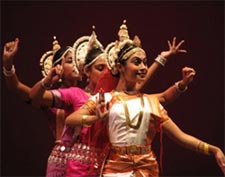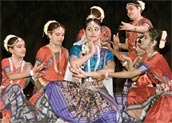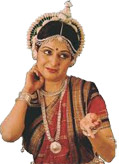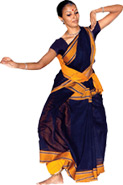ODISSI
Origin
Odissi is the traditional dance form of Odisha which owes its origin to the temple dances of the "Devadasis". Odissi dance history is traced between 8th and the 11th century, when the kings took great pride in excelling in the arts of dance and music in this period .Jayadeva's 'Geeta-Govinda' written in 12th century the Bible of an Odissi dancer has stupendous influence on the arts of Odisha culture. Odissi performances are replicate the lores of the eighth incarnation of Vishnu, Lord Krishna.The Odissi dance before the 17th century was held in great esteem due to patronage and support of local rulers and nobles. During this period even the royalty was expected to be accomplished dancers.

Odissi is one of the famous classical Indian dances from Odisha state. The history of Odissi dance is almost two thousand years old. Odissi is a highly inspired, passionate, ecstatic and sensuous form of dance. Like most of the South Indian classical dances of India Odissi too had its origin in the Devadasi tradition. The state of Odisha has a great cultural history. The rulers in this region built magnificent temples, which became the center of art and culture. It was during this period that in the temple Odissi which is one of India's scintillating dance-forms was born, nurtured and nourished.
Steps involved in the dance
Generally the Odissi dancers use their head, bust and torso in soft flowing movements to express specific movements, moods and emotions.
The most and enhancing features of Odissi dance is the Tribhangi. The notion which divides the body into three parts, head, bust and torso. These postures where dealing with the three elements are called Tribhangi. This concept of Tribhangi has created the very characteristic poses which are more twisted than found in other classical Indian dances. Mudra is an importantcomponent of Odissi dance and term Mudra means "stamp" and is a hand position which suggests things. Odissi themes are always seem to be almost religious in nature and mostly revolve around Krishna.
One of the circles revolves clockwise, while the other revolves anti clockwise. The dance is a very energetic and fast paced activity, which leaves no scope for lethargy. The dancers are accompanied by an instrument player with a 'meddale' drum. The person stands in the center of the two circles and leads the dancers with his beats. The site of hundreds of people swaying on the beats of folk music is awe-inspiring.

The very famous dance themes of the Odissi dance to interpret are divine love tales of Radha and the cowherd God Krishna, while a typical recital of Odissi will contain at least one or two ashtapadis which is a poem of eight couplet from Jayadeva's Gita Govindam, which has the lusture of exquisite Sanskrit poetry the complex relationship between Radha and her Lord.
Popular dancers
 Due to the efforts and initiatives taken up by the Experts for the reconstruction and popularization of Odissi dance. Some of the notable are Guru Deba Prasad Das, Guru Mayadhar Raut, Guru Pankaj Charan Das, Guru Mahadev Rout, Guru Raghu Dutta and Guru Kelu Charan Mahapatra, Mayadhar Raut , Hare Krishna Behera, Durga Charan Ranbir, Gangadhar Pradhan, Sonal Mansingh, Kum Kum Mohanty, Surendranath Jena, Kiran Segal, Madhavi Mudgal, Aloka Kanungo,Surupa Sen, Manoranjan Pradhan, Bijayini Satpathy, Sangeeta Das & Leena Mohanty
Due to the efforts and initiatives taken up by the Experts for the reconstruction and popularization of Odissi dance. Some of the notable are Guru Deba Prasad Das, Guru Mayadhar Raut, Guru Pankaj Charan Das, Guru Mahadev Rout, Guru Raghu Dutta and Guru Kelu Charan Mahapatra, Mayadhar Raut , Hare Krishna Behera, Durga Charan Ranbir, Gangadhar Pradhan, Sonal Mansingh, Kum Kum Mohanty, Surendranath Jena, Kiran Segal, Madhavi Mudgal, Aloka Kanungo,Surupa Sen, Manoranjan Pradhan, Bijayini Satpathy, Sangeeta Das & Leena Mohanty
How it is developed
Today the Odissi dance form is a well established and codified classical dance form of India. Odissi is marked a dance of love, joy and intense passion, pure, divine and human. Over a period time there are three schools of Odissi dance which have been developed, they are- Mahari, Nartaki, and Gotipau. The Mahari system traces its roots from the Devadasi tradition. From royal courts is called the Nartaki tradition developed. While in Gotipau tradition young boys dress up in female attires and enact female roles.Odissi dance current from is the product of a 20th century revival. The Dedicated scholars and dance enthusiasts have carefully researched manuscripts and studied the sculpture, painting and poetry of the region.
Learning the dance
Mysore Kala Kendra,Vani Villas Mohalla
Ph.no 821-4246101.
# 286/3, 6th Main, Vani Villas Mohalla, Mysore - 570002.
Bhavalaya
Dr.J.Retnakumar Chairman & Managing Director - 97461 46814
Prartana , Kalpaka Villas,Elamakkara, Cochin 682 026
Tel : 91 484 6451433
Email: [email protected]


